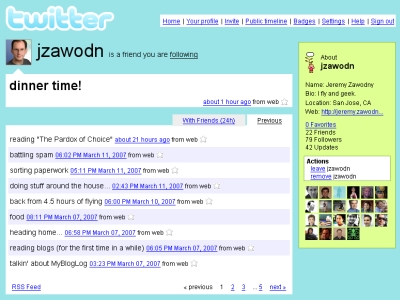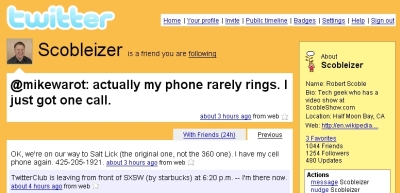I spent a good chunk of this weekend learning the ins and outs of Twitter, the service I blogged about not too long ago. In case you wanted to know and to establish contact, here I am. While I was preparing to clean the apartment for a visit from my father-in-law late Saturday night, I decided to use Twitter over more conventional methods, such as IM. One of those main benefits is that Twitter is still instant, but you’re not necessarily expecting an immediate response, so you really can multitask. (It helps to be immediate, though. I asked a question about Gmail and nobody answered me yet. π )

 In any event, it may be just because of the current SXSW conference, but I noticed that those SXSW attendees have been Twittering the weekend away. Literally. I’ve also noticed that there are really two types of users on the Twitter community. There’s the conversationaholic, the Robert Scoble, who makes those Twitter users come back for more (or scares them away with all that twittering — take your pick π ). Then, there’s the Twitter user in the literal sense of the site’s objectives. Jeremy Zawodny simply answers the question, “What are you doing right now?” It’s definitely interesting to see that Twitter is multi-faceted in this sense.
In any event, it may be just because of the current SXSW conference, but I noticed that those SXSW attendees have been Twittering the weekend away. Literally. I’ve also noticed that there are really two types of users on the Twitter community. There’s the conversationaholic, the Robert Scoble, who makes those Twitter users come back for more (or scares them away with all that twittering — take your pick π ). Then, there’s the Twitter user in the literal sense of the site’s objectives. Jeremy Zawodny simply answers the question, “What are you doing right now?” It’s definitely interesting to see that Twitter is multi-faceted in this sense.
Which user is better? Both types of users contribute to the appeal of the site. After all, Twitter includes the “functionality” for many types of users — it asks what you’re doing, which allows for Zawodny-style Twittering, but it allows you to converse with one another (tip for the newbies: reply to a post with “@name:” and it will appear to be a reply directed to that particular individual). Robert, the conversationalist, has updated Twitter 480 times since he has signed up (in 48 pages), whereas Jeremy, the “doer,” has only provided the world with 41 updates (5 pages). How much do you want to use Twitter? It depends on you, and the service allows for that.
An interesting trend emerges. Borderline obsessive compulsive Twitterers find the service a “micro blog” as Robert Scoble has put it, and he’s proven his allegiance many times over. I love that. I also love to just know about the tech blogger celebrities beyond their blogs, so the Zawodny-style Twittering habit isn’t stopping me from being a follower of his updates.
Ultimately, the Scoble-style Twitterbugs will make the site a success. An online startup needs to have a flavor and allure to keep the users coming. Another recent social network that I joined not too long ago, TickMe, simply doesn’t have that appeal beyond the initial “tick.” But with Twitter, every update is current, and if you want to know what’s going on in the life of your friends, you could simply log on and have a look at what’s new in TwitterWorld. Beyond that, there’s tremendous value for businesses, conferences, and finding out the latest news happenings. Twitter really integrates a great value into a nice package.
Is the hype surrounding Twitter going to be short term? After all, the Twitter Club currently seems to be congregated somewhere in Austin, Texas, and Chris Heuer thinks that communication will become difficult as more and more people sign on, a thought that was voiced Saturday night in the IRC channel (run by Chris Pirillo at irc.wyldryde.org #twitter). Despite Twitter’s momentum gain back when an earthquake hit the Bay Area, is SXSW the pinnacle for Twitter and is it the beginning of the end? Or is it just the start of a beautiful relationship, as they say? I suppose we’ll wait and see, but I personally see that Twitter’s popularity will continue as long as it continues to feature those long-lasting and engaging conversations.





I think these are some really good distinctions and thoughts, but there are even more types of users to consider. Those who use it like Dodgeball, those who use it to promote other media, those who use it to communicate with each other, those who microblog, those who take notes for themselves and probably another dozen types of users and user activities.
This is just the beggining, but the signal to noise ratio must be kept with the right sort of balance – at least for me. Some people may use it as a primary communications channel for keeping in touch with groups of friends, or just groups (we will use it for social media club). People will use it as they will… and that is the real point – it must be a personally relevant communications channel for it to succeed, and that it is.
Hey Chris, this is true and I touched upon it briefly in the post, though not as in depth as I could have (my emphasis on “two sides” really isn’t quite two-sided after all), when I said “Beyond that, theres tremendous value for businesses, conferences, and finding out the latest news happenings.”
To be honest, the Scoble-type Twitter user does kind of incorporate a lot of those ideas — microblogging, promoting other media (to a point), and communication, for example. I don’t see those who emphasize note-taking to be the best use of the “community,” but hey, Twitter allows for it, doesn’t it? π
I guess my intention was to show that there really is a super-Twitter user who really does do just about everything you could basically do on Twitter, but there also are those users on Twitter who use it “minimally.” The success of the service will be coming from the former rather than the latter, since something does need to drive people to continue to come back.
Tamar,
Great posting!
For me, the jury is still out on twitter.
Thanks to this post though, at least I have an idea of what I’m doing there…;-) LOL!
Judah, it took me awhile too, and I’m starting to feel inundated with all the posts!